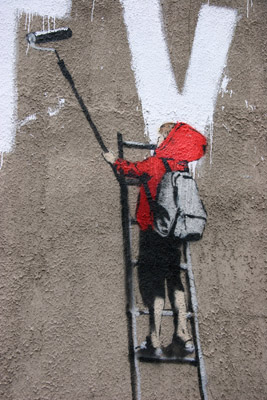In the video below, Carly Stasko, a culture jammer questions “we’re just ‘spose to sit back and take in like all the streaming commercials and television and messages and I’m just ‘spose to take it in… and it’s all ‘spose to stay inside?? no way!”
Carly discusses the point of creating a dialogue where there isn’t one; something I did not do. Our environments are filled with messages and it impacts us as people, but sometimes we should impact back with a response.
Like most teenage girls, Carly felt terrible whenever she looked at a teen magazine; “buy this lipstick”, “wear size 8 miniskirts”, “look sexy”. Do advertisers really want a mindless tramp army of teens? Well I guess if they’re selling their products (and making sales!), that’s all that really cares (to them). This is where culture jamming comes into play.
In order to jam an ad, you have to understand it so you can manipulate it to speak in the same language. This is something I was lucky enough to learn in my third year of my undergraduate course – deconstructing an ad, understanding the semiotics of it. Everything in an ad is there for a reason. Sometimes this reason can simply be to portray an expensive taste to a product, right down to hiding macro issues of the company or product itself, take for example Nike.
Nike was under fire in the 1990’s when it came to light their products where manufactured in sweatshops in third world countries. These people were underpaid, worked in terrible poor conditions, whilst the products themselves would sell for hundreds of dollars. This may have been one of the most recognisable culture jams to the world, as it played on memes that anyone anywhere could understand the restructured message to the brand.
One more important thing Carly brings up is the term “Mind Share”. This can be explained as the constant war for brain territory, that companies are more concerned with their mind share in youth population and exactly how you perceive and recognise their brands/logos. For me, Mac certainly now how a segment of my mind share, invading my own privacy to thought and decision making. With culture jamming, it threatens these companies’ mind share to consumers, as it makes individuals think for themselves and become educated about issues and facts that are often hidden and not discoverable on the front of an advertisement.
So since when are your eyes for rent? As it appears, they always have been. Always on the lookout for another catchy tenant who will pay the bills with product lines and the oh so great feeling of consumption. But once that consumption is overfilled, it’s only a matter of time before the landlord / YOU can step up, kick them out and have a say back, in a form that only that tenant understands.


I completely agree with the last paragraph of this blog entry. People have the ability to take control of their own mind share and decide what thoughts are allowed to reside there. But I question whether culture jams automatically put most viewers in that mindset. Zombies are zombies until they come in contact with a really sharp chainsaw. One simple campaign isn’t often enough to cut through the tens of thousands of images that brainwashed them in the first place. I think it takes dialogue in addition to a culture jam campaign to knock some sense into them. It takes a few who are strong enough to take control of their own mind share without outside assistance to influence their peers and point out converse messages. I guess I lack enough faith in the masses to believe they could understand even the most intelligent culture jam without a little hand holding.
Great thoughts Bryan. I would think Culture Jam’s scratch the surface / open our eyes to what is going on. I think by seeing a Jam, it encourages you to think against the norm, but not necessarily act. This is fueled by further repeat jams (even of different brands/ideas) that would persuade, or even further encourage such dialogue/reaction to take place as people become more aware, and learn the tools to speak back. Of course, a bit of ‘hand holding’ helps too!
I totally agree with your point that there are few who would be strong enough that see past blatant well-known advertisements. But for the rest (and majority), we rely on these Jams to bring a truth we weren’t aware of.
[…] previously referenced, Carly Stasko, a culture jammer said “I don’t condone this [jamming], but kids should know about it… […]
[…] media, as well as logos – the product and company are still recognised, yet with a new message. This how the most effect culture jams operate as I have said in other posts. If you can manipulate small changes in an ad, people can still understand what is going […]